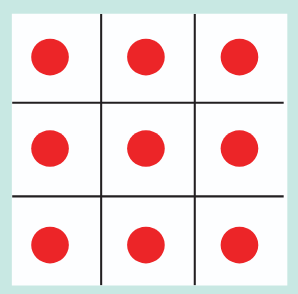A
…
B
Balloon Burst – Courtesy of ~ Paul Taylor and Danny Thomas
A game for the field. We use damaged bosses with the foam square blocks in our club. The central block was shot out on one of the bosses, so it was removed, and the resulting hole was maintained with a wooden frame, allowing you to shoot through it. A balloon was inflated and fixed behind the boss and about 20 cm from the hole, dangling on a string. About 30 yards away and in a moderate breeze, it took a very long time to burst the balloon.
Balloons – Courtesy of ~ goldengatejoad.com
One of the simplest archery games and one of the most satisfying for all ages and skill levels is shooting balloons. You can use any size or kind of latex balloon, and they are easy to tape to the target. If you are shooting with a youth group, you can enlist their aid in blowing up the balloons.
Variations
Goodies. Hang a candy or other goodies from strings tied to balloons. Whoever shoots the balloon earns the prizes. You can attach the balloons normally with tape to the ends, or to the target by tying a string around the inflated middle of the balloon and attaching the string to the target or suspend the balloons from a loop of wire such that the balloons fall through when shot. Coupons or raffle tickets can also be hung from or inserted into random balloons. Items inserted in balloons will be better off if the balloons are inflated with a pump or compressor as inflating them with your lungs makes them very humid inside.
A Pool-like game for 2 people: Blow up 8 small balloons of one colour and 8 of another. Tape them to the target randomly mixed. Toss to see who shoots first. Play in order, one arrow at a time. The first person to hit the colour claims the colour and tries to shoot all the balloons of that colour. The first person whose balloons are all shot wins. Accidentally shooting your opponent’s balloons counts in their favour. You can vary the game with pool-inspired rules, such as getting to shoot again if you make your shot; by mixing in some white balloons, which, if hit, count as a scratch; or adding an 8-ball balloon that has to be shot last to win, and scratches if you miss.
Battleships – Courtesy of ~ Paul Taylor and Danny Thomas
I created this game about four years ago to keep Kathryn Taylor entertained and motivated. It’s pretty simple with a face of 144 small targets (Archer’s Advantage scaled faces) printed 6 to an A4 sheet and then taped together.
In games much like you all played at school, I hid my fleet, drawn out on a 12×12 grid. Kathryn shoots an arrow and is greeted by ‘BOOM’ or ‘PLOP’ depending on whether she hits a ship or not. I tell her what ship she’s hit, and she then works out where the rest of the ship is and tries to sink it. We use Post-it notes to mark the hits and misses.
When she was young, she had to hit at least 7 to score a hit (at a minimum of 10 metres, the AGB Safe shooting distance); now she must score at least 9.
Markings
A=Aircraft Carrier
B=Battleship
D=Destroyer
F=Frigate
M=Minesweeper
X=Miss
Beat the Score – Courtesy of ~ A Third Party Subscriber
Match or beat your partner’s score. The participants are put into pairs. Player one takes the first shot.
Player two then attempts to either match or beat their score.
If Player 2 beats Player 1’s score, they keep that score, and Player 1 scores zero. If player 2 does not beat player 1 then player one gets their points and player 2 scores zero.
If the players have matching points, they both score. Both players shoot 3 arrows, then swap over.
Bingo – Courtesy of ~ ArcheryGB
This is an individual game. Each player is issued with a bingo card (ie a card with a random set of 20 numbers between 1 and 10).
Each player will shoot one arrow per end. The objective of the game is to shoot arrows into the corresponding number on your bingo card.
When an arrow is shot to correspond with a number on your bingo card, it is marked off on the card.
When all the numbers on your bingo card have been marked off then you shout ‘Bingo’! The first person to shout bingo is the winner.
[Requirements: a bingo number card for each player, a standard 10 scoring zone, pens, prizes]
Blackjack – Courtesy of ~ Laura Quantrill
21-challenge the archers to try and score as close to 21 points as possible without going over, whoever is closer in a pair of wins. You could say a double yellow from 2 arrows is an automatic 21, even if it doesn’t add up, because that’s pretty impressive, especially if they are beginners.
Bowling – Courtesy of goldengatejoad.com
Shoot at a regular 10-ring target. 10 is a strike. If you miss the 10, you can shoot the ring that will make your score add up to ten as a spare. So if you hit a 6, you have to shoot a 4 to pick up the spare.
Bowls – Courtesy of ArcheryGB
This is a team game; each team should have at least two players.
The instructor has a disk approximately 4 inches across, which they attach in a random position on the target face.All the players will shoot two arrows alternately and try to get as close to the Jack as possible.
At the next end, the instructor will move the Jack to another position on the target, and the players shoot again.
After 12 ends, the scores of each team are totalled, and the highest-scoring team wins.
The player who is closest to the Jack gains five points for their team.
Bullseye Bingo – Courtesy of Stephane Hockin – Runnymede
The setup requires Bingo-style cards with different target zones:
E.g. Hit a Gold
Hit a red
Hit a Blue
Hit any even-numbered ring and two arrows in the same zone
Miss the target
Arrow touches another arrow
Land an arrow exactly on a boundary line
Successfully call your shot before shooting (“I’ll hit blue”)
C
Closest Arrow – Courtesy of ~ goldengatejoad.com
Players shoot 3 arrows each. The closest individual arrow to the centre wins. You can do a rough score using the rings, but an actual measurement to the centre must be used if there are multiple arrows in the highest scoring ring.
Connect Four – Courtesy of ~ Archery Report
This is one of my favourites and can be a lot of fun. Similar to the game most of us played as kids with the plastic cage and checker pieces, the object is to get four arrows in a row. I’ve played this on grids as small as 5 by 5 and as large as 10 by 10. While similar to tic-tac-toe, this one tends to take more thought and more shots. You can shoot three to five arrows per end, and if someone hasn’t one yet, retrieve your arrows and mark the boxes with stickers and shoot another end.
Cricket – Courtesy of ~ Duffy Dowle and Gary Bellamy
Archers are placed into two teams of equal ability: Bowlers and Batsmen. On the toss of a coin, the team captain will call, and the winning captain will decide to Bat or Bowl.
The objective of the game is to score as many runs (points) as possible before the Batters lose all their wickets and are bowled out. To do this, the Bowler has to hit the Inner Gold (to score a wicket) as many times as there are Batsmen. Conversely, the Batsmen score 6 runs for a Gold, four runs for a Red, 3 runs for a Blue, 2 runs for a Black and 1 run for a White.
For every missed shot by the Bowler, an extra run is added to the Batting side’s score. This is called a wide.
For every missed ball by a batter, a wicket is awarded to the Bowling team. Archers shoot in Pairs, one from each team and shoot 1 arrow each.
Nobody drops out, and everyone keeps taking turns until the Bowlers succeed. When the Batters are Bowled out. The team reverses roles and repeats the process. The winners are the team with the most “runs”. In fairness, each team should shoot the same number of arrows, so no extra runs are scored after the last wicket has fallen. Target faces being used on the day it is determined by the organisers.

Connect 3 – Courtesy of ~ ArcheryGB
2+ players.
Two players take alternate shots until three in a row are hit (horizontally, vertically or diagonally).
Beginners shoot squares and advanced players shoot circles.
The game is played on an 8 x 8 grid drawn on the back of a target face.
Alternative: An archer shooting their arrow into a previously occupied cell loses their turn.
Play as individuals or as a team and decrease the grid size to increase difficulty.
[Requirements: bespoke target face or on the back of a standard one, use tape/large marker to draw a grid, prizes]
Crazy Scoring – Courtesy of ~ ArcheryGB
This game involves using a standard target face. After each end you change the value of the scoring zones. For example, in the first end, the scores may be:
gold = 9, red = 7, blue = 5, black = 3, white = 1 and a miss = 0.
In the second end, the scores may change to: gold = +5, red = -20, blue = +15, black = -10, white = +20 and a miss = +10.
In the third end, you can change the scores again and so on until you want the game to end.
[Requirements: standard five-colour zone target, a list of crazy scores per end, prizes]
Cut Outs – Courtesy of ~ ArcheryGB
This is an individual game scoring by colour.
The archers shoot at a target which has random shapes or ‘black holes’ added to the target face – some of these shapes/holes should be pretty large.
The archers shoot their arrows, and if an arrow lands in a hole, then there is no score for this arrow. If an arrow lands on a colour, then the archer will receive the score for those colours. The archers should shoot two dozen arrows, and the person who has gained the most points wins.
D
Darts – Courtesy of ~ Dave Beeton
40cm, 60cm, 80cm, 122cm Dart target faces are available from most archery retail outlets.
Most professional matches are “501 up”. This is the simplest of games. Each player starts with a score of 501 and takes turns shooting 3 arrows. The score for each turn is calculated and deducted from the player’s total. Bullseye scores 50, the outer ring scores 25, and an arrow in the double or treble ring counts double or treble the segment score. The objective is to be the first player to reduce the score to exactly zero, the only caveat being that the last dart thrown must land in a double or the bullseye.
If a player reduces the score to 1 or goes below zero, the score is bust, that turn ends immediately, and the score is returned to what it was at the start of that turn. e.g. if a player has 32 to go out and the first dart is a 16, the second is a 15, the player is bust and the score is returned to 32. So on the last turn, it is not necessary to throw all 3 darts – a player can win with the first or second dart of the turn.
Because a player who misses a targeted double is likely to score the single of that segment, good players attempt to leave themselves with a repeatably bustable number, such as 24 or, ideally, 32 – double 16. So for instance, if a player has double 16 left, and hits a 16, he has double 8 left and if he then hits an 8 he has double four left and so on – this is advantageous because no extra darts need to be thrown in order to reduce the score to an even number… It so often happens that people reduce their score to 1 (typically aiming for double 1), and some people play a very unofficial rule called “splitting the 11”. This rule says that when the score is reduced to 1, instead of going bust, the player must “split the 11” by shooting an arrow between the two numbers forming the number 11 on the edge of the board. This is tricky.
301 is played in precisely the same way, but players start the game with 301. Some games require a double to start scoring as well as to finish the game.
When the score goes below 171, professional players know the numbers to aim at in order to check out in a single turn with 3 darts. Here is a table of such combinations.
Dice and cards – Courtesy of ~ Marc Rowley
Get a dice and also a pack of playing cards, and separate the ace through to the 6, in each suit (discard the rest). 2 teams, 12 games. Each team rolls the dice, and the number on the dice will correspond to a number on the cards, i.e roll a 3, then pick a 3 card (any suit, it doesn’t matter). The 2 opposing team members pick up their cards, based on the dice number they got, and place them on a board 18m away. You have 6 arrows to hit every suit picture, in the middle of the card (you get a 3 of hearts, then hit all 3 hearts in the middle of the card). Add up the scores at the end to see which team wins.
Dice with Death – Courtesy of ~ Jason Phillips
Ideal for limited experience archers, as the ideal approach is to scatter arrows in all colours on the target. You will require a dice with target colours designated to each number – e.g. 6=Gold, 5=Red….and 1=“a reward”; Or set up a spin the wheel or get an app that does this on your phone for each colour. Each arrow is a “life” – start with 6 lives! Allow all to shoot the end – when completed, roll the dice. Any arrow in the randomly picked number/colour is “dead” and is left under the target for the remainder of the game. If using a dice, then one can be rewarded with a life/extra arrow…or if you are feeling mean, then you can use this to remove one arrow from everyone! Lives will also be lost when an arrow is outside a scoring zone.I suggest you define line breakers up front! Either 1-you say that line breakers count for both colours and this means you are increasing your risk of death, or 2-you agree that you can save your life if you are touching another colour – choose one but not both, as this causes a bit of an argument! Continue to shoot ends until there remains a winner with a “life”/arrow left.
Dollar Game – Courtesy of ~ Archery Report
At my hometown archery club, we used to play this every night after paper leagues. Each person takes a dollar bill and folds it in half four times then hangs it up downrange using golf tees. Everybody then picks a different bill to shoot at than their own. If you hit one, you keep it. If someone else hits yours, you’re out! The game continues until no bills are left. I should probably mention it might be better to use a different target and just have everybody put a bill into a pool. That was,y you don’t end up going to the bank with a bunch of bills with holes in them!
E
Eliminator – Courtesy of ~ Jason Phillips
ideal for new archers – this game gets harder as you progress! Each arrow is a “life” – start with 6 lives!
Lives will be lost when an arrow is outside the designated scoring zone. “Dead” arrows can be left under the target for the remainder of the game.
End 1 – Allow archer to shoot in all scoring zones (white and inwards) – retain arrows/lives that achieve this.
End 2 – Archers shoot Black and inwards (losing all lives outwith the black)
End 3 – Shoot Blue and inwards….and so on
When you get to gold, only you can be flexible as per time allows to either keep everyone on that has lives left, or say the closest to the centre spider wins. You can make this a harder version if you like by defining a specific colour only in which you can keep lives for each end…but avoid this for less experienced archers!

